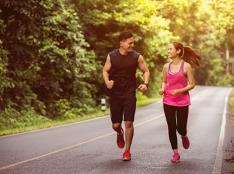
Strength training provides a long list of benefits to all runners. For trail runners, it's particularly advantageous.
The nature of trail running often requires less speed and more strength in order to navigate technical terrain and steep climbs and descents. Indeed, the many obstacles along any trail require a good amount of all-around athleticism to run from start to finish as fast as possible, all while skirting injury.
"Strength training is valuable no matter the terrain and although it's important for navigating uneven trails, feeling comfortable ascending and descending is likely of larger value," says Steve Gonser, a physical therapist and founder of RunSmart Online.
Many trail runners prefer ultra events that require an increased number of hours spent training and racing. The fatigue that sets in during the latter stages of a run can expose muscle weaknesses and imbalances and, ultimately, lead to a long list of injuries.
More: 25 Best Trail Running Destinations in the U.S.
"In the presence of mental or physical fatigue, the mind and body adapt to a 'whatever works' model and the neuromuscular system will grasp at straws to continue forward motion," says Gonser. "Major compensations due to mental and physical breakdown apply shearing and rotational forces to joints, ligaments and tendons."
You can ward off many of the risks involved with overcompensation and other related injuries by including strength work in your training. If you're a trail buff looking to up your game or simply prevent recurring ailments, consider focusing on the following areas of the body.
More: 15 Technical Tips for the Trail
Hips
Trail running requires not just forward motion, but also the occasional lateral movement. Whether you're barreling down rutted switchbacks or hopping sideways to avoid a rock in the trail, hip stability is important for performance and injury prevention. Running requires you to effectively pull your leg from behind your body to the front, balance on the landed foot, and then propel yourself forward. The hips play an integral role in every phase of running; if there are deficiencies in that part of the kinetic chain, you may trip over the rugged terrain or get injured.
Try this: Clamshell
Lie on your right side on the ground with your legs together and your knees bent at a 45-degree angle. Slowly lift the right leg, opening the clamshell while keeping your feet and ankles together. Close and repeat 10 to 15 times.
Glutes
Related to the hips, the gluteus maximus and medius are also integral to the movement of running. These muscles, which are involved in the tilting and stabilization of the pelvis, dictate how efficiently you're able to move through the gait cycle. While the larger of the two is the most powerful, both are important when it comes to everything from landing to propulsion. Weak glutes can also contribute to injuries like runner's knee and iliotibial band syndrome.
Try This: Single Leg Squat
Stand on your right leg with your left leg off the ground and extended in front of your body. Slowly squat by bending your right knee, balancing with your arms. Be sure to keep your right ankle aligned with your knee, rather than over your toes. Stand up and repeat 10 times on each side.
More: 5 Squat Variations for Runners
- 1
- of
- 2
About the Author

Get ACTIVE on the Go


Couch to 5K®
The best way to get new runners off the couch and across the finish line of their first 5K.
Available for iOS | Android







Discuss This Article